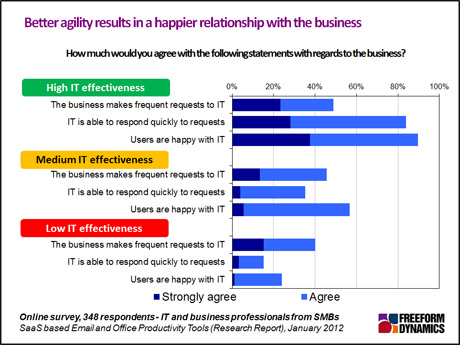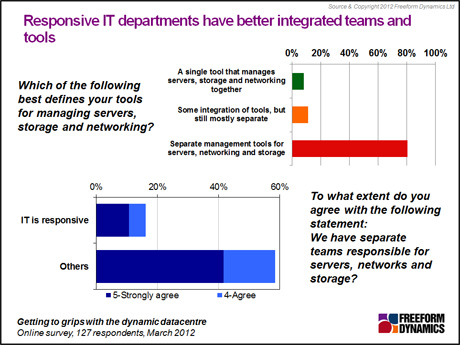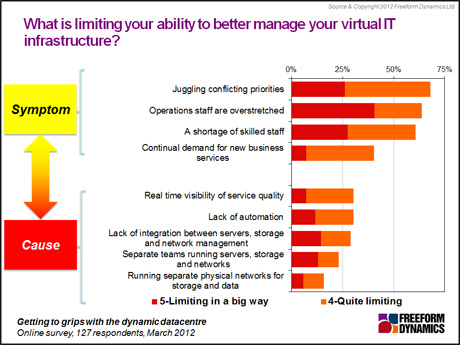One of the certainties when it comes to running IT is that change is constant. Modern businesses depend more and more on IT services to run all manner of business processes, and being able to get new or enhanced services up and running quickly can have a material impact on the bottom line.
In a number of recent research studies, we’ve been looking at what tends to make some IT organisation better able to handle change. In one study, we looked at respondents’ capabilities across a wide spectrum of IT investment, management and operations capabilities, we were able to group them according whether their IT effectiveness was high, medium or low.
The situation emerged that companies of all types regularly make requests for new or enhanced services to IT, no matter how effective the IT organisation. But it’s clear that IT agility, which marks out the ability to respond effectively, is a hallmark of those who make better use of their IT investment (Figure 1).

Figure 1
We hear all the time from the large community of IT vendors about how new products and technologies can make IT more agile and responsive. With all the column inches devoted to the topic, we might be forgiven for thinking that a lot of IT departments are getting adept at dealing with change.
However, our on-going research highlights that for the vast majority of companies out there, IT continues to struggle here.
One of the major issues contributing to difficulties in handling change is that the IT infrastructure is usually structured in individual siloes that operate quite independently from each other, both from an operations team perspective, but also the systems themselves and the tools used to manage them.
Yet if we group together those IT organisations that are responsive to change and separate them out from the others, it is plain to see that they are much more likely to have an integrated approach to not just teams, but the tools they use (Figure 2).

Figure 2
When it comes to change requests, these findings back up the difficulties that abound when separate teams take their own approaches to managing change. Co-ordinating dependencies and progress blockers can be more difficult, and a lot of the time the process works in a serial manner as each team does it’s bit and moves it onto the next in line, rather than a lot of the work being done in parallel. This adds to the time and cost involved in managing change.
We’ve been researching the links between better integration of management, systems and teams for years, and these results are repeated each time. So what is typically holding IT back from improving the situation?
In many cases, the lack of progress is down to what IT focuses on in day-to-day operations. Things that are top of mind here are usually dealing with a team that are trying to cover too much ground, prioritising investments that are allocated around specific systems or projects, or a lack of skills. While these are all problems that affect the ability to implement change, they are very much the symptoms of a deeper root cause of fragmented systems, tools and teams that few recognise (Figure 3).

Figure 3
Getting to grips with the problem of agility will require focusing on tackling the fragmentation that is part and parcel of most IT setups, otherwise the situation will continue to persist with fire-fight after fire-fight eating up valuable time and money.
Progress will almost certainly be slow, and big changes, particularly steps such as integrating the different server, storage and networking operations teams, are likely to be politically charged. However, the long term health of both IT and ultimately the business will depend on bringing the teams more closely together, particularly as virtualisation and private cloud require much closer co-ordination and automation, creating natural dependencies.
Improving change management and operational processes so that they are co-ordinated is a useful initial step. When it comes to disjointed toolsets, throwing everything out to implement a single suite may not be possible, although it does tend to improve the situation if it can be done. The pragmatic approach is usually to invest in getting existing tools working better together.
When it comes to making change routine, integrated management and management processes are key. However, these are not something that is as visible or exciting as the next new application project. Therefore, it is vital to make the business case to spend time and money on integrating and unifying the IT infrastructure and operations. It will be a hard battle, but the results make it one worth fighting.
CLICK HERE TO VIEW ORIGINAL PUBLISHED ON

Content Contributors: Andrew Buss
Through our research and insights, we help bridge the gap between technology buyers and sellers.





Have You Read This?
From Barcode Scanning to Smart Data Capture
Beyond the Barcode: Smart Data Capture
The Evolving Role of Converged Infrastructure in Modern IT
Evaluating the Potential of Hyper-Converged Storage
Kubernetes as an enterprise multi-cloud enabler
A CX perspective on the Contact Centre
Automation of SAP Master Data Management
Tackling the software skills crunch